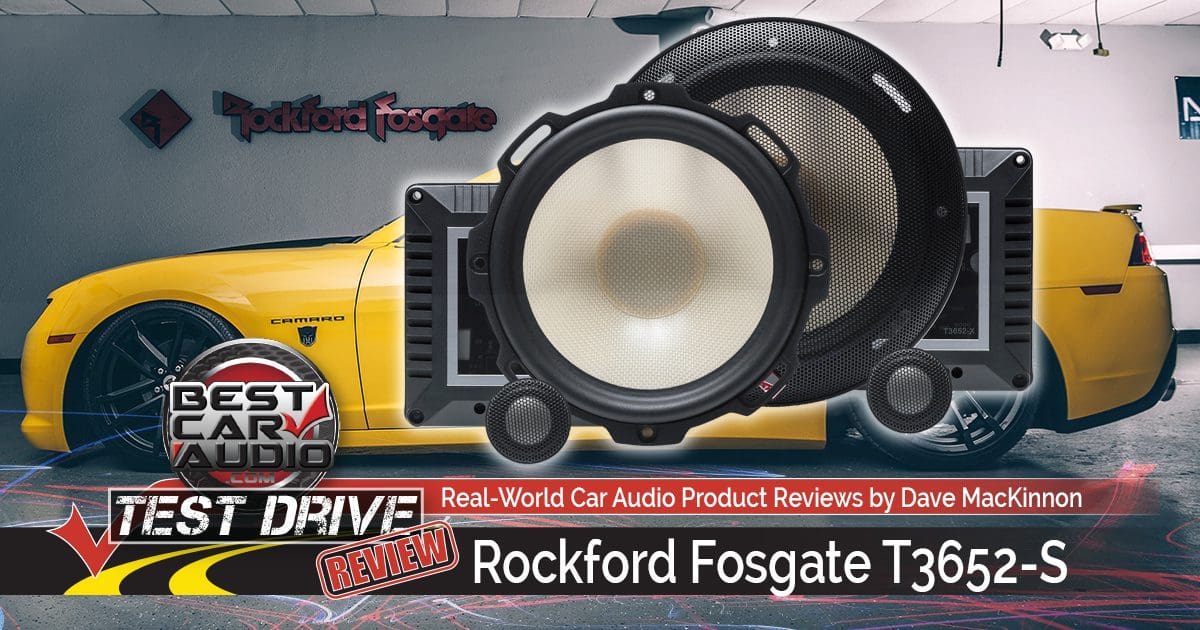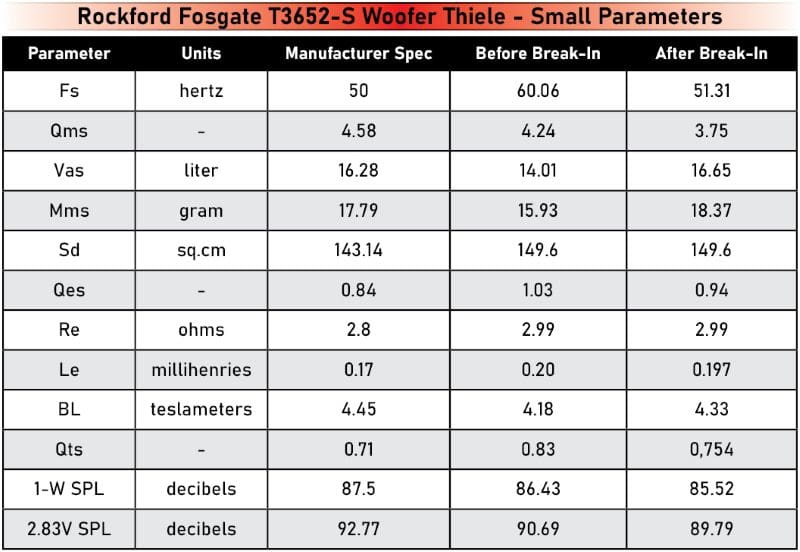Can you learn much about a speaker set by looking at a feature list and spec sheet? In the case of the Rockford Fosgate T3652-S 6.5-inch audiophile component speakers, the answer is a resounding yes. From the sizeable 1.5-inch voice coil and integrated induction management to the liquid crystal polymer woofer cone and intelligent mounting hardware for the tweeter, we’ve already got technologies that many brands that claim to be “high-end” are missing. Add what looks like a ruler-flat frequency response according to the spec sheet, and we’re more than ready to rock ’n’ roll. So, let’s see what makes these speakers tick and set them up for a critical listening session.
Design Features of the Rockford Fosgate T3652-S Woofers
Out of the gate, the first thing you need to know is what comes with the T3652-S kit: a pair of 6.5-inch woofers, a pair of 1-inch tweeters and two passive crossover networks. Grilles for the woofers and mounting hardware for the tweeters are also included for your installer.
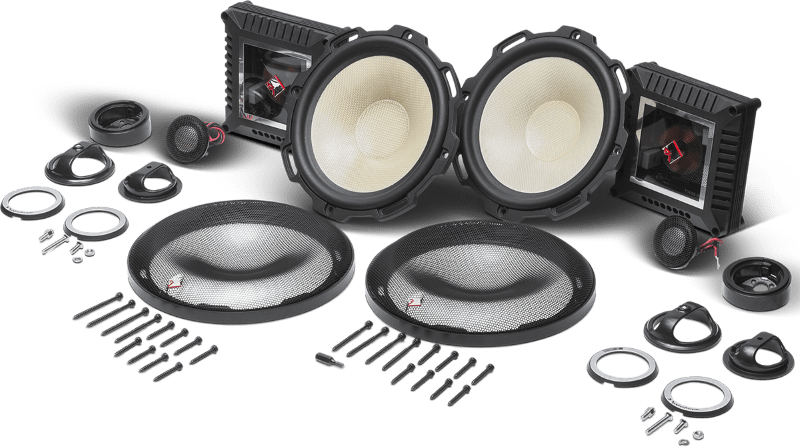
The woofers are based on a proprietary cast aluminum basket. The mounting plateau for the linear Nomex spider is positioned perfectly so that no spacers are required, nor is there a cupped spider design. Cupped spiders are a shortcut that results in non-linear compliance and a dramatic increase in distortion, especially at high excursion levels. In addition, the area beneath the spider plateau is protected with mesh and is otherwise open to allow heat to escape from the voice coil and the motor assembly. This open design also eliminates the chance of air pressurizing under the spider, which can also cause distortion.
As I mentioned, the drivers have a 1.5-inch voice coil winding that can handle 125 watts continuously and peaks of 250 watts. Electrical connections are made by a set of dual-function terminals on the basket. Your installer can use the provided spade terminals or insert bare wires and secure them in place with the provided 2-mm hex-head set screws. The connections from the terminals to two-layer voice coil winding are handled by a pair of woven tinsel leads sewn to the spider. A second set of leads on the opposite side of the spider ensures that compliance is equal on both sides to promote linear motion.
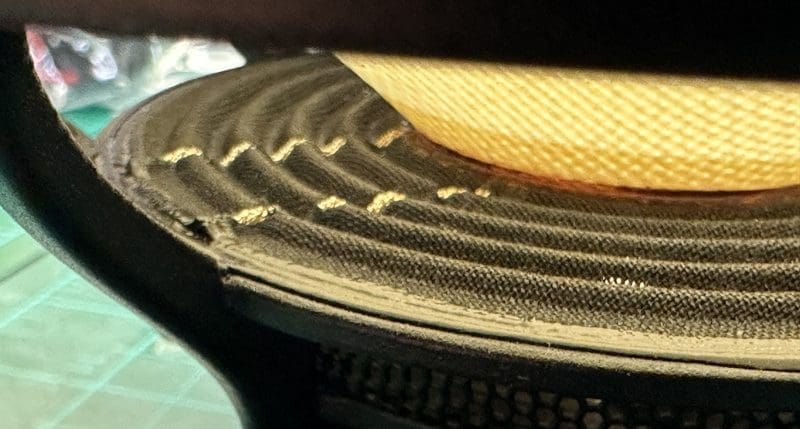
The woofer uses a neodymium magnet enclosed in an extruded aluminum heatsink. The heat sink is part of Rockford Fosgate’s Inductive Damping Heat Sink technology. Keeping the motor assembly cool helps to reduce thermal compression – a phenomenon that diminishes speaker output as it gets hot. The design also includes a shorting ring beneath the top plate. This shorting ring reduces the inductive characteristics of the voice coil to improve upper midrange clarity. Voice coil induction management is a crucial technology in any woofer or midrange driver that claims to be an audiophile solution.
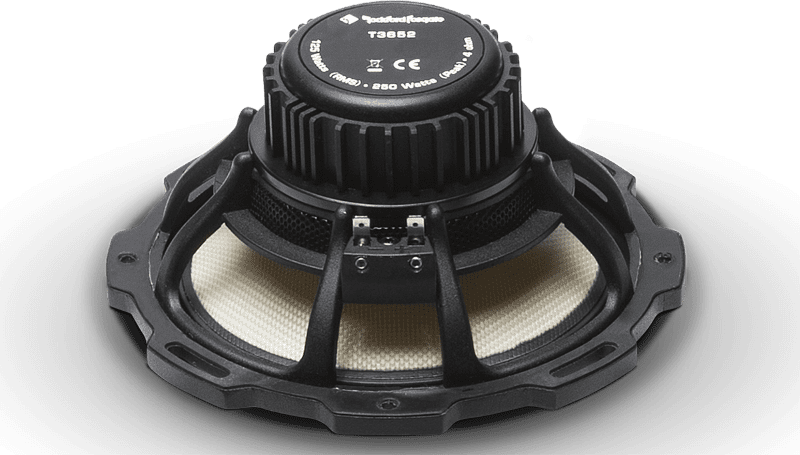
Up top, we find a butyl rubber surround bonded to the basket using Rockford Fosgate’s Vertical Attach Surround Technique that increases the effective cone area of the driver. This woofer has an effective surface area of 143.14 square centimeters. Compare that with measurements of 128 to 132 from other high-end drivers, and you’ve got at least 8% more effective cone area to increase efficiency and low-frequency extension. The basket includes four mounting holes on a 157-mm bolt circle and four slots as part of the Flex-Fit basket design. The kit includes two lengths of hex-head mounting screws and a hex bit for your screwdriver or cordless driver.
The woofer cones are made from a liquid crystal polymer thermoplastic resin that offers an outstanding balance of mechanical strength, impressive heat stability and chemical resistance. When formed into a thread and woven together, the result is a woofer cone that’s very low in mass while offering excellent resistance to deformation. In addition, a dust cap pressed from the same material is used in the center of the woofer to keep debris out of the voice coil gap and increase the effective cone area of the driver compared with designs that use a phase plug.
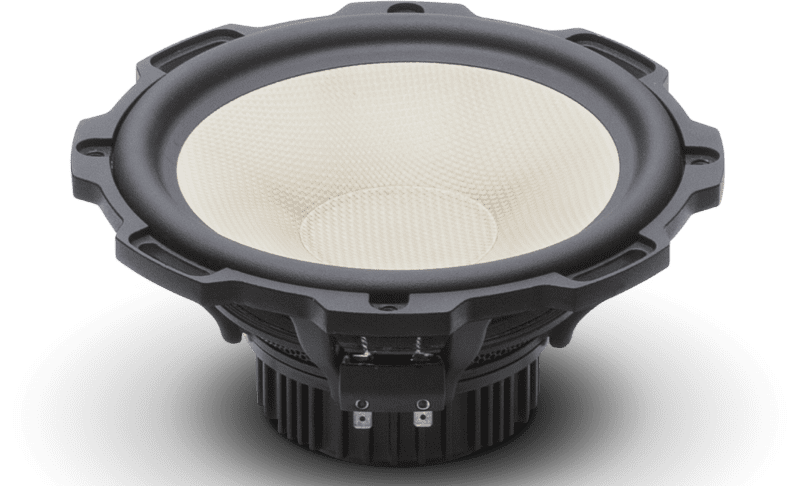
T3652-S Tweeter and Crossover Technologies
The tweeters in the Rockford Fosgate T3652-S component set also feature a liquid crystal polymer diaphragm. A treated silk surround provides compliance for the moving structure. The voice coil is woven on a 1-inch diameter aluminum former. A neodymium slug is the heart of the tweeter and offers excellent efficiency in a compact package.
Unlike many of its competitors, Rockford Fosgate has put significant effort into ensuring that your technician has a variety of options available for installing the tweeters. Proper mounting hardware is another item that many brands overlook. The tweeters can be flush-mounted using the Discreet Dual Clamp mounting system. If the tweeters are to be surface-mounted, the nest cups clamp the trim panel securely while allowing the driver to be serviced easily from the front. The drivers can also be surface-mounted using the provided pods that include both shallow and steep angles on the rear to aim the drivers appropriately. Finally, a mesh grille with a translucent diffuser is mounted permanently to the front of the drivers. Without any of the included mounting hardware, these drivers should be small enough to serve as a replacement in many OE applications.
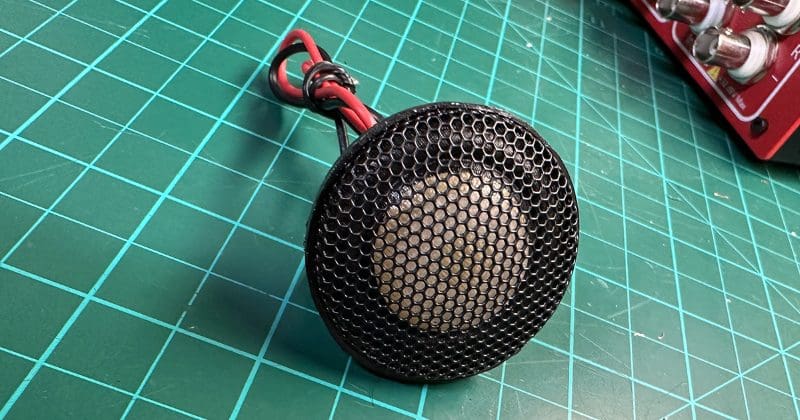
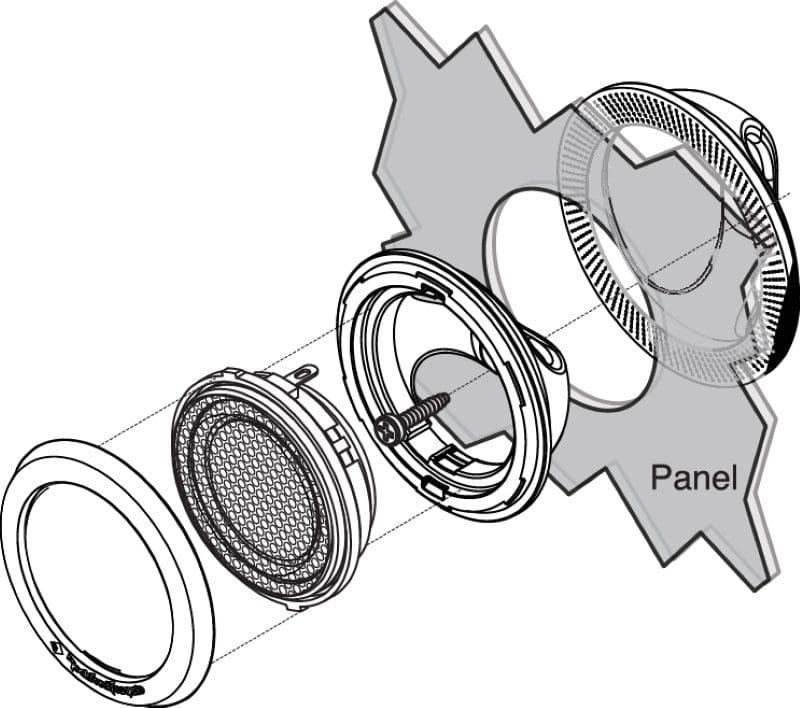
The system includes a pair of passive crossover networks housed in a 4.6-inch-square case. The networks have dual inputs, and an internal switch allows your installer to enable the bi-amp option if they wish. There’s also a switch to select between on- and off-axis installations to optimize the tweeter’s output for different installations. Finally, a tweeter level output switch selects between -2, 0 and +2 dB levels to provide some fine-tuning in the event the system doesn’t have a digital signal processor or bi-amplification. Rockford Fosgate notes that the system uses a third-order high-pass Butterworth filter for the bottom of the tweeter and a second-order Butterworth for the top of the midrange.
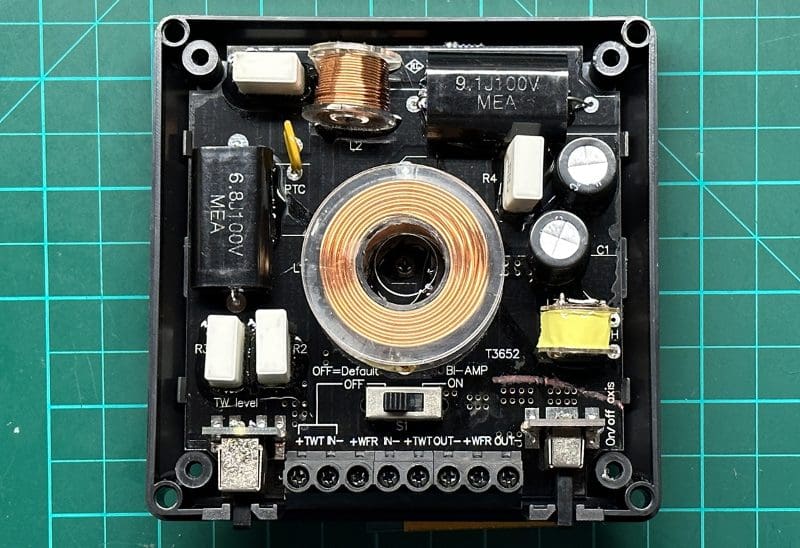
T3652-S Bench Evaluation
Purely for my curiosity, I start every transducer review by measuring the Thiele/Small parameters of the woofers. I set them up on the bench and play a low-frequency test tone through them to exercise and stretch the suspension for about 10 hours. In the case of the T3652-S woofers, the resonant frequency of each driver dropped from 60 Hz to 52 Hz, and the compliance softened a bit from 14.01 liters to 16.65. These aren’t huge differences, but they will be perceivable in terms of bass performance in your vehicle.
The measured specifications for both drivers are very close after break-in, with the Fs varying by about 1.5 Hz and the Vas by 0.3 liter. These are well within acceptable tolerances for a high-quality component set. Let me put that another way: I’ve seen worse from driver sets that claim to be “the best.”
It’s easy to measure the large-signal Thiele/Small parameters of the tweeters, but I can tell you that they have a resonant frequency of 1.44 kHz and a nominal impedance of 4 ohms. Once again, both samples were very similar – a sign of excellent quality control.
Let’s look at what the above information tells us about the woofer. First, the Qts value is perfect for a speaker intended to be installed in a door. The compliance of the air in the door won’t have much effect on the woofer, so we are left with a total Q around 0.75. Finally, the relatively small Vas of the driver indicates that it’s not an ideal solution for a small enclosure, further supporting infinite-baffle application in a door or rear parcel shelf.
I modeled the factory specifications (in yellow) and the as-measured specs (in red) in BassBox Pro to see what the curve looked like. The software suggested a sealed enclosure with a volume of 2.3 cubic feet to keep the Q low. This could be reduced to 1.3 cubic feet if you would accept a Qtc of 0.8. Cramming this woofer into a 0.3- to 0.5-cubic-foot enclosure, as is found on many displays, results in a Qtc of 1.0 to 1.1, which will make it sound sloppy. If you want to hear how good this woofer can sound, it should be auditioned in a vehicle with proper installation.
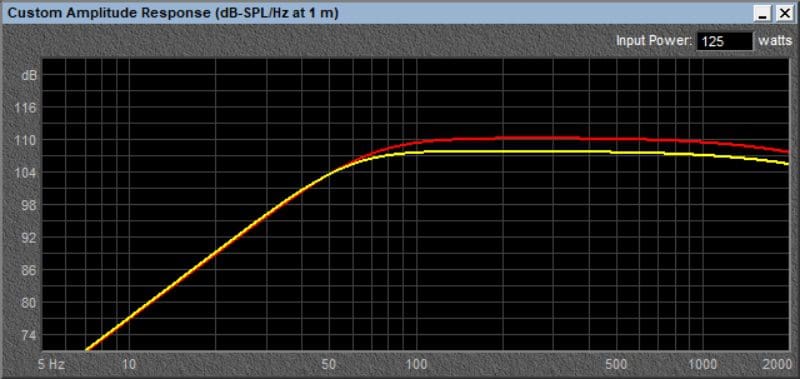
I also checked the predicted excursion capabilities of the driver when powered with the as-specified 125-watt maximum continuous rating. As long as you have a high-pass crossover set to at least 70 hertz, excursion won’t be an issue. As there’s no benefit to a lower crossover point when a subwoofer is used, I recommend using a fourth-order Linkwitz-Riley crossover at 80 Hz on both the woofer and the subwoofer. If you plan on running the woofer without a high-pass filter, limit the power to prevent low-frequency excursion issues.
Next, I set up one of the woofers and tweeters with the passive crossover network to make some impedance measurements of the system. The system has a nominal impedance of 4 ohms, and this is reached between 150 and 300 hertz. No matter the settings on the crossover, the network will be easy for an amplifier to drive. I had a look at the impedance of the network with the different tweeter levels and installation (on- or off-axis) settings. The graph below shows the added resistance for the three tweeter output levels and what looks like a change to the crossover point between the on- and off-axis settings.
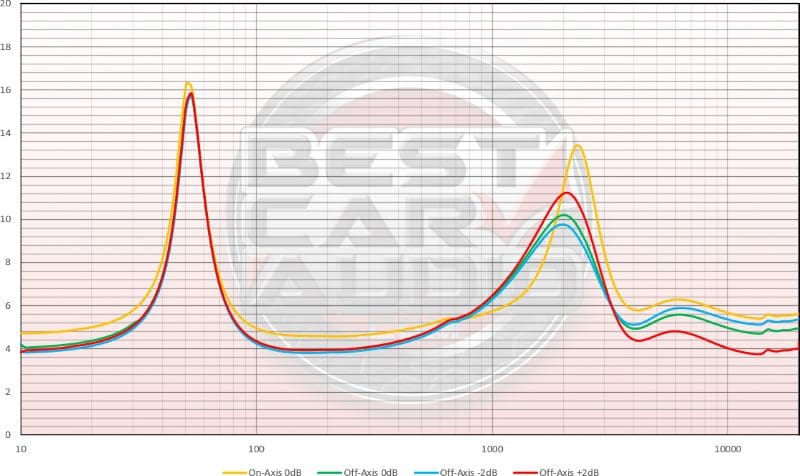
The next step was to set the speakers up in my 2.2-cubic-foot sealed test enclosures. The front baffle of the enclosures is 12 inches wide by 36 inches tall. I mounted the tweeter just above the woofer on the face of the baffle. From here, I set up my RTA microphone at a distance of 0.2 meter from the point in between the drivers to start making response measurements. Any farther away and reflections off the floor and ceiling of my listening room negatively affect the midbass frequency analysis. I fed the speakers with a 2.0-volt sine sweep and went through the different crossover settings to quantify their effect on the output. The graph’s amplitude is scaled to match a measurement distance of 1 watt at 1 meter.
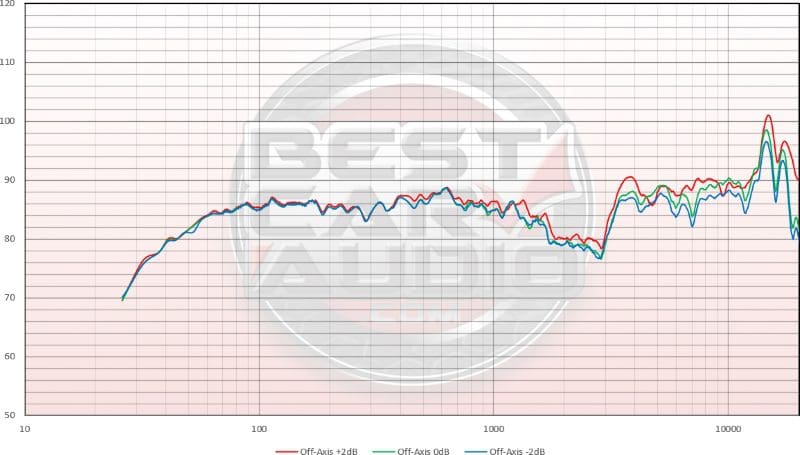
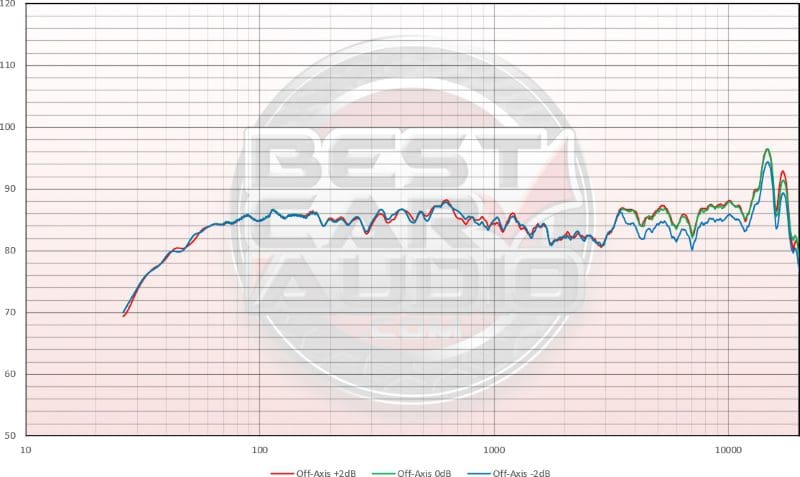
As predicted, the response is very smooth through the midbass and midrange. The on/off-axis adjustment affects the output of the system just below the crossover point. A small cone breakup around 700 Hz was noticeable in the impedance graphs and the acoustic response graph. The top end of the tweeter, beyond the range of human hearing, also has a few resonances. Let’s see if either of these shows up as anything egregious in the listening evaluation.
Auditioning the Rockford Fosgate T3652-S Component Speaker Set
I drove the speakers with my reference 300-watts-per-channel high-bias Class AB amplifier and modified DRZ-9255 source unit. The crossover was set to the on-axis position, and the tweeters were at the -2 dB setting.
The first track I listened to was “Turn Me On” by Norah Jones. Unlike my reference speakers, which have a laid-back sound, the T3652-S is more forward. This design brings out the minute details in Norah’s voice. The balance was smooth, and there was no sense of sibilance or brightness at any point. The organ in the background was easily heard. As this is a relatively low-Q woofer, there was no emphasis on the lower midrange.
Next, I listened to “You Should See Me in a Crown” by Billie Eilish. The metallic “rips” at the beginning of the song will absolutely get your attention through these speakers. Again, nothing was bright or harsh, but the system has a very flat and neutral balance that can be attributed to the induction management of the voice coil in the woofers. The result is impressive clarity and detail in every note Billie sings. She’s not muted or whispery, as you might find with other speakers. If you have lots of bass in your vehicle, these are a great speaker choice to ensure that you can hear all the vocals clearly and with impeccable detail.
Finally, I played “Money for Nothing” by Dire Straits. The vocal during the introduction was “airier” than through my reference speakers. In short, there was more, better, upper midrange output. The drums that begin at 12 seconds into the track had amazing impact. There was no softness or muddiness – just a nice sharp attack to every stick strike. The lead guitar at 36 seconds was downright awesome. It wasn’t just a guitar sound. Every note and the harmonics of the distortion processing was rendered with amazing detail. As I turned the system up louder and louder, nothing changed in terms of balance or dynamics, and it didn’t become harsh – it just got louder and louder. How loud was it? Well, I didn’t know my reference amplifier had clipping indicators. What an amazing experience!
If you’ve ever wondered what the difference between mediocre and high-end component sets is, one of the key features is that the good ones can be played loudly without sounding harsh or edgy. If you’ve ever walked around a modern stereo show and listened to distorted vocals from those PA-style speakers people cram into their doors – this is the opposite of that disaster.
Technologies such as large voice coils, inductance management and linear suspension geometry are keys to this success. Many brands that, as I’ve said before, claim to be “the best” don’t have these features and don’t sound as good as these. Rockford Fosgate has done an amazing job of optimizing technology to ensure that owners of the T3652-S can crank their music and have it sound great.
We should address the “midbass thing” with these speakers. In a typical woofer, some manufacturers may choose a higher-Q, higher-Fs design that adds some emphasis to the output between 100 to 200 hertz. If the speakers are being used without a subwoofer, these design choices can give the system a warmer sound. However, the high-Q has the drawback of adding distortion, as the extra sound output is caused by the woofer cone continuing to resonate after the signal stops. These aren’t ultra-low Qts drivers, but they are low enough and have a low resonant frequency so as to deliver smooth and linear frequency response in the midbass region. In short, to optimize the performance of your audio system, you’ll want to use these speakers with a subwoofer.
Summary Thoughts on the Rockford Fosgate T3652-S Component Speaker Set
From a scientific standpoint, Rockford Fosgate has optimized the performance of the T3652-S set to deliver impressive clarity. The shorting ring and large two-layer voice coil deliver excellent upper midrange performance. The “neutral midbass” design choice keeps midbass frequencies taught and controlled, even at crazy output levels. The tweeter has no problem keeping up with the midrange to reproduce the highest frequencies.
From an application perspective, you’ll get the most enjoyment from these speakers when they are used with a subwoofer. This is a conscious decision that comes with the woofer design. With that said, you don’t need a wall of subwoofers or to sacrifice your entire cargo area. A P3-1X12 powered by a T500-1bdCP would be stunning. Drive the T3652-S speakers with a P300X2 or one of the four-channel Power Series amplifiers and the DSR1 in an active configuration, and your mind will be blown!
Tonally, these aren’t old-fashioned speakers that many enthusiasts have grown used to. Their technologies improve their performance to deliver music the way it was mastered in a recording studio. It’s not mellow or mushy – it’s neutral, accurate and controlled. This clarity makes these great speakers a great choice to keep up with systems that have a lot of sub-bass or for those who are tired of mushy, old-school speaker designs. If you are shopping for a set of car audio component speakers that sound excellent and can play loudly without all the distortion most expect at outrageous volume levels, drop by a local authorized Rockford Fosgate retailer and ask about the T3652-S component set. You’ll likely never think of speakers the same way afterward.
For more information on Rockford Fosgate’s speaker, amplifier and subwoofer solutions, visit their website. Follow them on Facebook, Instagram and Twitter. Their YouTube channel has some amazing product and event videos – you’ll want to check that out too! Most importantly, you can use their dealer locator to find an authorized retailer near you to get your car, motorcycle, boat or off-roader set up with their amazing mobile entertainment products.
